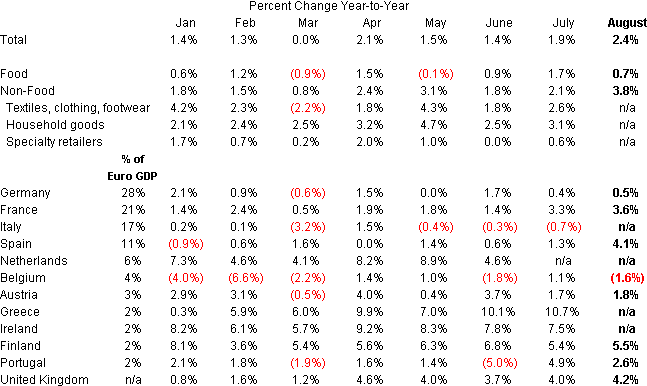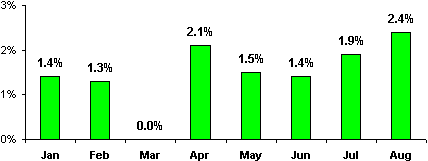IDEX Online Research: Euro-Zone Retail Sales Continue to Strengthen in August
October 19, 06
Retail sales in the Euro-Zone in August continued to strengthen for the third consecutive month. On a year-over-year comparison, retail sales in the Euro-Zone (12 countries with a common currency) were up 2.4 percent from August 2005. This is the strongest gain so far in 2006, and is well above July’s gain. The graph below summarizes monthly retail sales in the Euro-Zone.
| 2006 Retail Sales Trends - Euro Area |
Retail sales in all 25 European Union countries were stronger than sales in the Euro-Zone. The 25 EU countries reported an aggregate retail sales gain of 3.3 percent for August.
We note that retail sales for August are preliminary, and do not reflect results for all countries. Further, preliminary July retail sales were revised downward, when results from all countries were finally reported, and we expect further minor revisions over the next few months as final results are tallied and analyzed.
Retail Sales Strongest in Non-Food Categories
Euro-Zone retail sales are subdivided into two major categories – Food and Non-Food. Retail sales of “food” rose by a very modest 0.7 percent in August, while “non-food” retail sales were up by a very robust 3.8 percent. This reflects the trend of most prior months: retail sales of non-food categories have consistently outperformed the food category.
Because Euro-Zone retail sales are summarized by broad categories, jewelry sales are not reported as a separate sub-category. However, because jewelry demand tends to reflect broader market trends, it is likely that jewelry sales in the E-Z strengthened in July.
Consumer Demand Generally Sold Across All E-Z Countries
Of the 12 E-Z Countries, eight have reported preliminary retail sales for August. Of those eight geopolitical regions, only one country – Belgium – reported a decline in consumer demand. Even Germany, which had been a laggard, posted modestly positive retail sales in August. Germany represents about 28 percent of the Euro GDP. Likewise, France, which is about 21 percent of the E-Z GDP, also reported a solid retail sales gain.
The table below summarizes retail sales trends for the Euro-Zone and the individual countries which make up the region.
2006 Euro Area Sales Trends Source: EuroStat

Outlook Calls for Continuing Solid Sales Gains
In August, merchants reported that almost all retail categories showed increased sales, reversing June’s decline and reinforcing the positive trend that was established in July. In particular, sales of textiles, clothing and footwear, household goods, and books and newspapers were solid.
The resurgence of these retail categories is linked to improved employment levels across the E-Z. Further, most economists are calling for continued improvement in the labor markets.
The outlook for E-Z retail sales is strong. Slower growth of consumer prices, coupled with the expectation of higher prices in 2007, may encourage shoppers to visit the malls and shops now, rather than delaying purchases. However, there are risks. In addition to the possibility of retail price inflation, the ECB is expected to further tighten its key lending rate. Thus, higher interest rates could stifle credit growth, taking consumer demand down with it.
